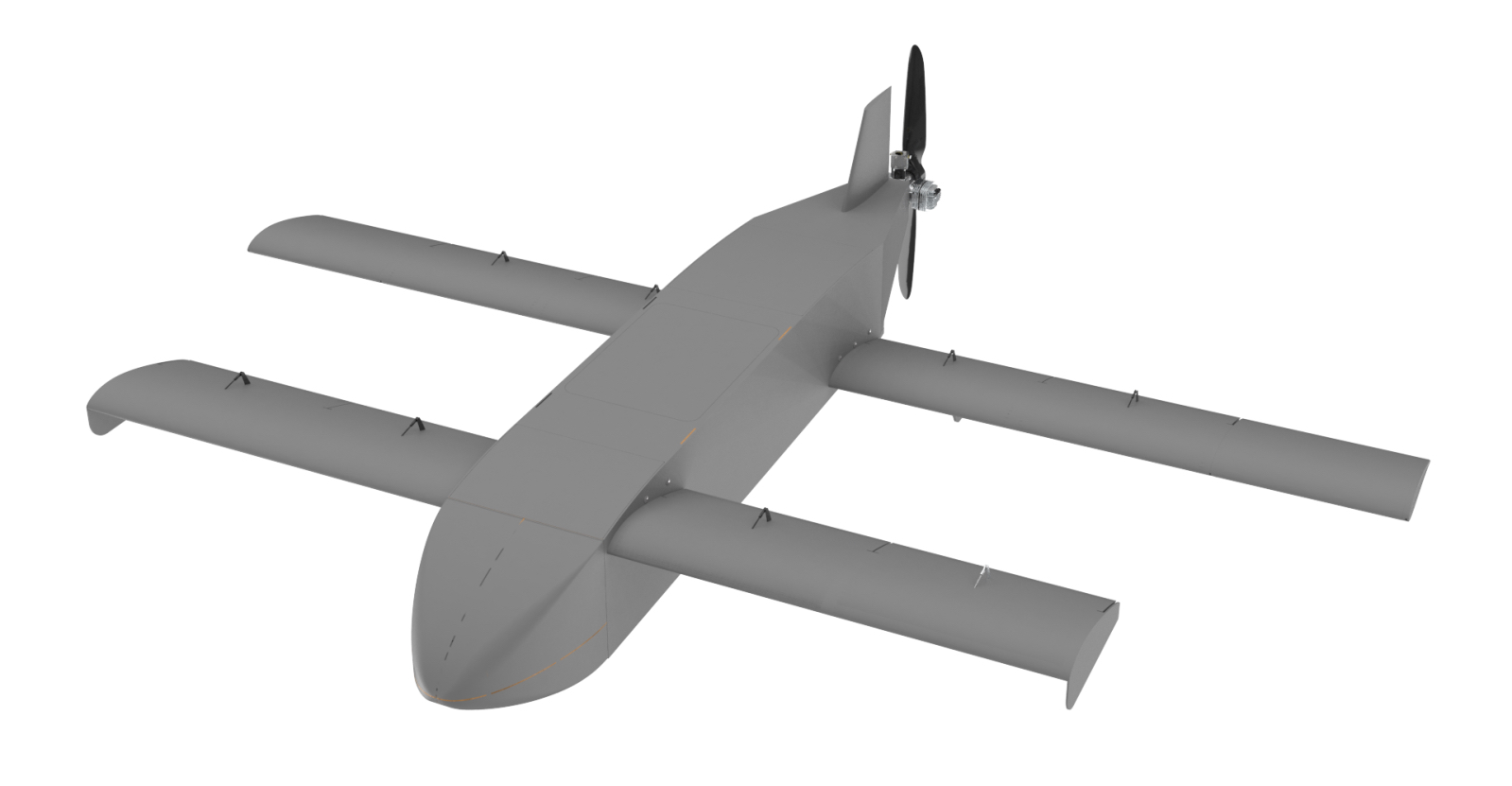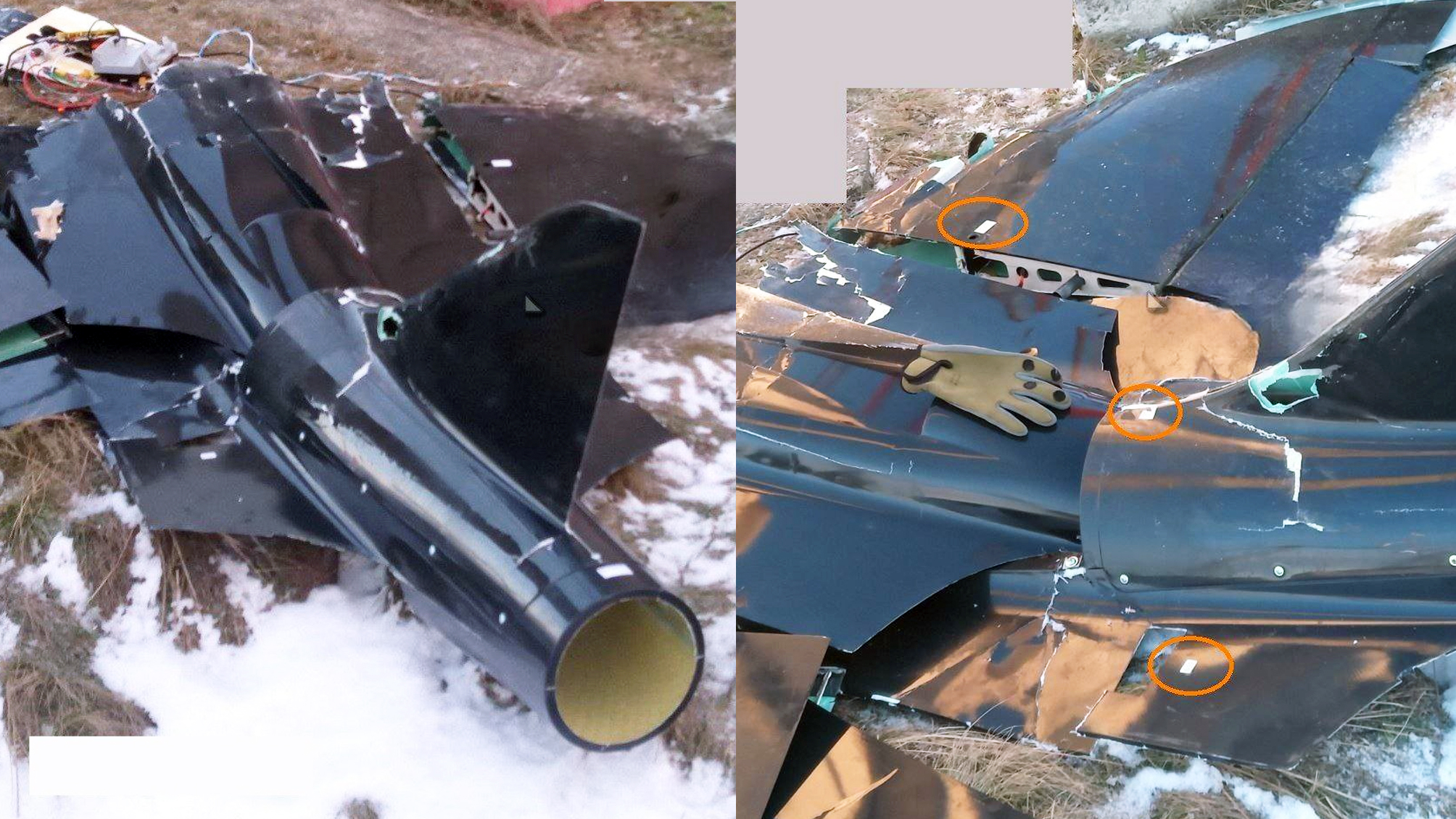The wreckage of a new Ukrainian jet-powered attack drone has appeared in Russia. So far, we know very little about the origins of the drone or its precise capabilities. Still, it signals, once again, Ukraine’s increasingly active development of long-range one-way attack drones as a means of taking the fight more directly to Russia.
A series of photos that appeared today on social media show the wreckage of one of the drones — the name and manufacturer of which remain unknown — and reveal some details about its construction and components. At this stage, it’s unclear if this particular drone crashed or was brought down by Russian air defenses.
The sleek, black-painted drone appears to be roughly 10 feet long, with a delta wing of a similar span and with a slightly curved ‘ogival’ leading edge. The drone has a swept tailfin but seems to have no horizontal tail surfaces. Based on accounts from Russian military bloggers, the drone is said to make use of a wooden construction with some carbon-fiber parts and fiberglass skin.
Inspection of the wreckage indicates that the drone is powered by a commercially available micro turbojet, installed in the tail section, and fed by a conformal intake below the fuselage. Specifically, the engine is a P400-PRO from the German JetCat company. This turbojet weighs only around eight pounds, has a diameter of a little under six inches, and has a thrust output of 95 pounds. This engine is often used by hobbyists in high-end remote control aircraft and is ready available for purchase online, with prices generally around $10,000 to $12,000.

No evidence is seen of any targeting system, suggesting that, like many other drones of its kind, it is autonomously flown by autopilot to strike a pre-selected set of coordinates.
Also seen among the wreckage are ball bearings, presumably from a blast-fragmentation warhead. Observers have noted that the warhead is very similar in appearance to that carried by another Ukrainian long-range one-way attack drone, the UJ-26 Beaver, a propeller-driven design that appears to have been fairly heavily utilized.


Ukraine’s UkrJet produces the UJ-26, along with other kamikaze drones that have been used to attack Russia proper. Whether this new design is another UkrJet product or not is currently unknown. The company’s existing offering already include a jet-powered type, the stealth-looking UJ-25 Skyline, which was adapted from a target drone.
Jet engines provide a considerable speed advantage, but are also expensive and, crucially, consume much more fuel to achieve the same range as their propeller-driven brethren. This reduces range. The performance of the drone in question is unknown, but its high-speed and hard-to-detect design — in terms of shaping, lack of exposed components, relatively small size and wood and composite construction — would make it more survivable than slower, cruder types. Still, a more limited range could mean it can only be employed against targets deep behind Russian lines and more shallowly beyond the Ukraine-Russian border.
UkrJet also makes the propeller-driven UJ-22, a design that has been shown with a payload of externally mounted bombs, but which can also be armed with an internal warhead. Videos indicated that this drone — which has an estimated range of 500 miles — was used in the series of notorious attacks against Moscow in 2023.
Beyond this newly emerged design and the ones produced by Ukrjet, Ukraine has been employing an increasingly diverse fleet of other long-range one-way attack drones acquired from various sources to strike targets, often deep within Russia. The first known strikes of this kind, which occurred back in May of 2022, was executed via adapting airframes available on Alibaba, Chinese-made Mugin-5s, for this role. Use of that type continued in high-profile ways, but it has become far less prominent over the last year as purpose-built types entered into service.

There had also been a trend noted early in the war involving Ukrainian Soviet-era Tu-141 and Tu-143 reconnaissance drones fitted with warheads to strike Russian targets (and in one case, accidentally strayed into airspace over the Croatian capital, Zagreb).
The Ukrainians have adapted other existing drones into one-way attackers, including types originally designed as aerial targets for training and test purposes like the Morok and aforementioned UJ-25.
Bearing a broad visual similarity to the Turkish-made Bayraktar TB2 medium-altitude long-endurance (MALE) that is also used by Ukraine, the Lyutyy has the same characteristic twin-boom layout. It has been used to strike targets deep within Russian borders, including the city of Nizhny Novgorod.
Even once advanced Western cruise missiles began to enter its arsenal, Ukraine continued to busily pursue its long-range one-way attack drone developments, especially since missiles like the Storm Shadow and SCALP EG are restricted for use against targets outside of Russia’s internationally recognized borders.
Recently, for example, The War Zone examined the AQ-400 Scythe, produced by the Terminal Autonomy company as part of a volunteer-led project and now in quantity production. Driven by a pusher propeller, the AQ-400 has an unusual configuration with forward and rear sets of wings and can launched under its own power via tricycle gear from short strips or can be launched by catapult or by small rocket boosters.

The AQ-400 reflects a particular Ukrianian trend for austere, low-cost, long-range one-way attack drones, but there have been other, even more spartan designs as well.
In recent days, photos showing the wreckage of a seemingly previously unknown drone that came down in Russia were published, The drone in question featured a distinctive inverted V-tail and was used to target an oil refinery in Yaroslavl late last month. This, together with another type of drone that appeared in December 2023 appears to stress ease of production and low cost. Essentially, these kinds of designs ally a commercially available engine driving a propeller to a basic airframe and a warhead, sometimes crudely attached rather than integrated within the airframe.
These are just some of a wider range of designs, some of them experimental, that have already been put to use by Ukraine against targets in Russia. Indeed, the drone that appeared in the photos today may well also have been used in combat before now.
There is also the possibility that the kamikaze drone seen in the pictures that emerged today is not entirely of Ukrainian origin, like the modified Mugin-5s, or has even been sourced entirely from outside the country. Last year, the United Kingdom pledged to send “hundreds of new long-range attack drones” to Ukraine, but has since declined to provide any further details. There is some resmblenace to the U.K.’s Banshee target drone, but it isn’t a direct match.

The appearance of this new jet-powered attack drone also follows a report from the Kyiv Post about a Swiss-based aviation startup called Destinus, which is run by a Russian dissident and says it is supplying Ukrainian forces with drones, including ones capable of attack ground targets. The company says it has already supplied a propeller-driven design and “two other models are also at various stages of development and will soon go into full production and be provided to Kyiv,” according to that story.
At this point, we don’t know if the new drone is in series production or whether it was being employed partly on an experimental basis. Time will tell if it becomes a more familiar sight attacking targets inside Russia or deep into Russian-held territory. Once again, however, it provides evidence of the high priority Ukraine has assigned to long-range, one-way attack drones, which have been the key to attacking valuable targets in Russia — including energy infrastructure — as well as providing a morale-boosting way of ‘bringing the war home’ to the enemy.
Contact the author: thomas@thewarzone.com
